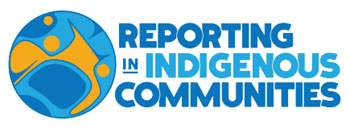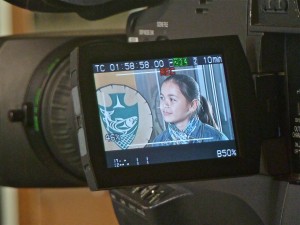02 Jan On educating journalists about Aboriginal issues
This past October, I sat down to talk with Langara College journalism student Jesse Winter for an article he was freelancing to rabble.ca about media coverage of Aboriginal issues. He focused his piece on a “good news” story he believes is under-reported — the Hobbema Community Cadet Corps. You can read his article here, but Jesse was kind enough to share with me the full transcript of our wide-ranging interview, so that I could post it to the RIIC blog.
JW: First of all, can you tell me a bit about your UBC course, Reporting in Indigenous Communities, and what it aims to accomplish?
DM: I just met with the students to sort out what we’re going to be doing next term and I asked them two basic questions in a survey. One of the questions I asked was “sometimes when I meet with Aboriginal people that I’m going to interview I feel _____________.” Fourteen people had answers like unsure, nervous…those were the two big ones. That may be common among students in general because you’re still learning, but I think a lot of reporters in general have a nervousness when they go to do stories about Aboriginal issues because they feel unprepared, uneducated perhaps on the issues, or they feel that there’s a tension and Aboriginal people and the media in general. So they go in thinking that there’s a tense situation that they’ll have to diffuse.
The point is to try to introduce students to Aboriginal issues and reporting from these communities in a safe environment, and work through some of the difficulties, have feed back and develop a basic cultural literacy of Aboriginal issues before they get thrown into the working world.
If you live in Canada and you’re a reporter, you are going to have to cover Aboriginal issues in your career.
As a BC journalism school, we sometimes have people who can go through the program and not actually learn anything about reporting on Aboriginal issues.
It’s not a First Nations studies course. It’s not a history of Aboriginal people. We’ll do some of that, but it’s a reporting course, so that’s why we’re sending people out into the communities.
JW: When I was working in a small town newsroom in Alberta, I found there was a fair amount of resistance to covering Aboriginal issues. During my time time there the content didn’t go much beyond the usual photo-spreads of National Aboriginal Day. The editor felt it wasn’t important to the community, even though there was a reserve right on that community’s doorstep, and conflict between the two was not uncommon. Why do you suppose that resistance still exists?
DM: Actually, that goes against the grain. In general small town papers tend to do a better job of covering Aboriginal issues simply because they’re neighbors. The see each other at the Tim Horton’s every day, where as the big city papers tend to be more removed. The Aboriginal people they would come in contact with on a regular basis would be urban Aboriginal folks, and it’s easy to never come into contact with Aboriginal people.
Morley, Alta, is a community that has a long history with its neighbors, and it’s not a good one. In that particular paper there may be a dynamic where it’s ‘us’ and ‘them.’ There may still be that tension. It might be an area that they don’t want to go to, or don’t feel welcome in.
JW: Hobbema, Alta, is another community that has a long and complicated relationship with the media. A lot of the members of that community feel the media only sensationalizes the gang violence and doesn’t do a good enough job covering stories like the Hobbema Community Cadet Corps. How good a job do you feel the media have done covering that community?
DM: I know the community feels the media has done a terrible job. I know that’s how they feel. It’s also a community that has some really, really big problems. So there’s a balance there that needs to be struck. That’s a great news story, the cadets. And my understanding of how that story came about is that the CBC in Edmonton, after a lot of complains from Hobbema saying ‘you only cover the deaths, you come down here all the time and that’s all you ever see,’ Edmonton spent some time saying listen, we’d like to tell some positive news stories coming out of Hobbema as well. So they spent some time building the relationships with the cadets, and that rolled over into them going to Jamaica with them. And that’s not cheap, for a media outlet to do that. So they turned into a couple of long docs, which again is prime real estate to have a big feature like that. So it was a big commitment on the part of CBC Edmonton, and it paid off. It was obviously a well-received story.
That said, what’s happening in Hobbema shouldn’t be happening. Five-year-olds shouldn’t be getting shot. There are long-standing questions about where the community should be going, and the gang issues are scary to all kinds of people. And those things need to be reported. I think what the folks from Hobbema are frustrated with is that when that ends up being on the front pages regularly, people start painting that entire community with the same brush.
On one hand that you can make the debate that the folks in Hobbema probably feel that they’re being targeted or that there’s bias, but the media focus on death in general quite a bit, and the unusual. And kids getting shot up is relatively unusual in Canada. So that’s why the media is there. The problem is that media is really good at reporting on problems and not so great at reporting on solutions. Reporting on problems is easy. It’s black and white. Solutions don’t necessarily happen in a 24-hour news cycle. They’re often gray and sometimes confusing. We lose interest. So we move on to the next novel thing. So we don’t see a lot of focus on reporting in the community about people who are attempting to solve these things.
There are people in Hobbema I’m quite sure, who are doing great things and working on solutions. But unfortunately those stories don’t make the front page.
“If it bleeds it leads” isn’t new. The problem is, though, when it’s focused on a racial group you end up with the concern that Indians are being painted as problem people.
JW: How difficult is it to get all the necessary context and background into a news story for a show like The National?
DM: Again, the challenge if I get assigned a news story on a Native issue, I’ve got a minute-forty-five to tell that story. Let’s say the head of the B.C. Treaty Commission decides to pull the plug. It’s been so many years and we’ve spent X amount of millions of dollars, and so maybe it’s time to pull the plug. Trying to build in the whole history of the Indian land question in British Columbia, the history of colonialism, the troubles with land negotiations, the Calder case, all of this into a minute-forty-five, that’s really tough.
What happens is you get these stories that don’t necessarily have a lot of context to them. And that’s troubling to Aboriginal people who just see a story about rotten houses that doesn’t have the colonial history of how we got there.
As I’m sure you know by know, you’ve only got 500 words, you have to focus on the key issue of the day. So what happens is you get these stories that don’t necessarily have a lot of context to them. And that’s troubling to Aboriginal people who just see a story about rotten houses that doesn’t have the colonial history of how we got there. And it ends up being boiled down to ‘Indians have rotten houses, and have their hands out for more money.’ Those are the two lines that come out of this, without exploring any of the responsibilities that INAC might have had for getting into that situation in the first place or any of the treaty negotiations involving housing, or any number of those issues.
So it’s our job, if we’ve only got a minute-forty-five, if we’ve only got 500 words, we’ve got to figure out ways to get that context in there because we’ve got to assume that most Canadians don’t necessarily have a broad education on Aboriginal issues.
So that means doing things like web extras. It means having a one-two punch in a newscast, having the news of the day at the top and then having a follow up piece that puts it in context. It means having side-bars in your magazines, so you go ‘OK, here’s the history of the B.C. treaty process.’
We need to figure out ways within our own mediums to offer that context.
It may be that Canadians don’t have that context because they lack preparation in school, or it may be because Canadians seem to have collective amnesia when it comes to colonial history.
I’m always kind of astounded when people say they don’t know anything about residential schools. It’s not for lack of material. There’s tons of material out there. It’s because for some reason people shut off when they hear about residential schools.
JW: Could part of that be due to Canadians feeling exhausted by all the negative coverage that’s told in the same pattern over and over, especially if they don’t have all the cultural understanding to interpret it?
DM: Yes. And again, that’s the media’s responsibility. Anyone who does any in-depth work should know the history so they can report it. But there’s no shortage of information out there.
When the Royal Commission on Aboriginal Peoples came out with their huge report in 1996, they said ‘we were astounded over and over and over again, what came up was the pain of residential schools and how much that still lingers, the intergenerational trauma.’
And that’s what grew into the lawsuits and the Truth and Reconciliation Commission, and all that. But the truth is that, for Aboriginal people, the residential schools are today. It’s now. But for a lot of non-Aboriginal people, they don’t understand that. They don’t get it. They say ‘get over it, move it, it wasn’t my fault.’
‘Some priest stuck his dick in your mouth, but it’s time to move on.’ Aboriginal people will keep trying to heal from that, and part of the healing is telling those stories. And the media, to a certain degree, want to try to tell those stories, but we keep telling them in the same way. We go out and find a survivor who tells their terrible tale of getting whipped in residential school for speaking their language, and we cut to some black and white stock photos and say ‘this all happened a long time ago’ and we get a lawyer to talk about the legal issues, and we get a politician to comment and then we wrap up again with the survivor who says ‘I’m still in pain.’
It’s always the same structure, the same story. So why wouldn’t you excuse your audience for changing the channel or turning the page in the paper when it’s the same story we keep telling them over and over and over again.
It’s a challenge telling those stories, there’s no question, but we’ve go to figure out a way to tell those stories creatively in a way that does grab people. It’s a challenge, believe me.
JW: So, what advice can you offer to new journalists who get assigned an Aboriginal story?
DM: If you are a reporter, listen. Treat Aboriginal people with respect. That’s it. That’s what my entire course boils down to. It’s not rocket science. But it’s way more complicated than that. What I mean is that, as reporters, Aboriginal and newsroom cultures fundamentally clash in terms of our understanding of time. We have brutal daily deadlines. A lot of Aboriginal people have a different understanding of time. Things take longer because processes and protocols are expected to be followed. So you need to appreciate.
Media are, fundamentally, story takers. We go into communities, we ask people to tell their stories, we take it away and then we tell it however we damn well please. Which is our prerogative, given editorial independence, which is critical. And we have some ethics, which guide us. Truth, balance…but who’s truth? We are ultimately story takers. Aboriginal people have a long history of people coming into their communities and saying they want to help, and taking things away, and not having any voice in how their stories are told.
Aboriginal people today are rightly saying ‘we want to have some control over how our story is represented, whether it’s by missionaries or by media.’ And that conflicts with how you and I do business on a daily basis.
Aboriginal people today are rightly saying ‘we want to have some control over how our story is represented, whether it’s by missionaries or by media.’
And that conflicts with how you and I do business on a daily basis. You’re taking all these notes, and you’ll go back and think about it, focus it down. You may or may not send me a version of your story, but I can’t do anything about it. That’s your story now.
So that’s the two things. Time, and the idea of consent. They can be solved if people listen to what Aboriginal people are saying about the way we do business and if we try to do our best to respect what they’re saying.
JW: So we should be more story tellers and less story takers?
DM: That’s a big question, a bigger question that I’m not going to tackle here. I’m going to let you wrestle with that. It’s a big challenge, but I don’t think that we ask the question enough in the newsroom about what consent means when people share their stories.






